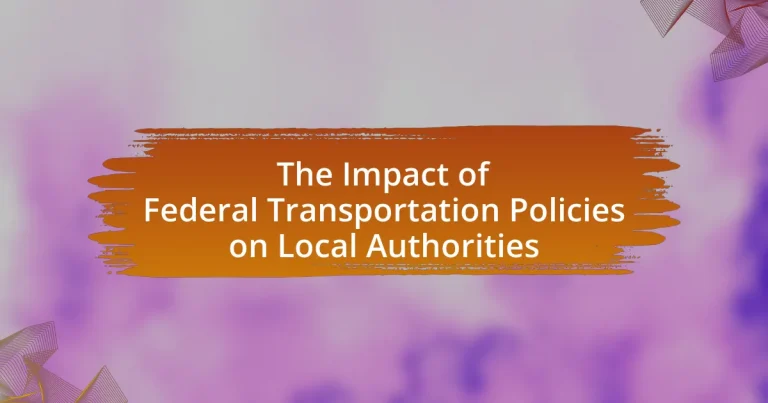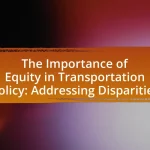Federal Transportation Policies are regulations established by the U.S. government to manage transportation systems, ensuring safety, efficiency, and accessibility across various modes such as highways, public transit, rail, and aviation. These policies significantly influence local governance by providing funding mechanisms and regulatory frameworks that shape local infrastructure development and planning. Key components include funding sources like the Highway Trust Fund, safety standards, and environmental considerations, all of which local authorities must navigate to secure federal support for transportation projects. The article explores the formulation and implementation of these policies, their impact on local transportation systems, the challenges faced by local authorities, and strategies for effective compliance and collaboration with federal agencies. Additionally, it addresses future trends in federal transportation initiatives, emphasizing sustainability and technological advancements.

What are Federal Transportation Policies?
Federal Transportation Policies are regulations and guidelines established by the federal government to govern the planning, funding, and operation of transportation systems across the United States. These policies aim to ensure safe, efficient, and accessible transportation networks, addressing various modes such as highways, public transit, rail, and aviation. For instance, the Federal-Aid Highway Act of 1956 initiated the Interstate Highway System, significantly shaping national transportation infrastructure. Additionally, the Fixing America’s Surface Transportation (FAST) Act of 2015 provided long-term funding for surface transportation projects, illustrating the federal commitment to maintaining and improving transportation systems.
How do Federal Transportation Policies influence local governance?
Federal Transportation Policies significantly influence local governance by establishing funding mechanisms and regulatory frameworks that shape local transportation infrastructure and planning. These policies, such as the Federal-Aid Highway Act, allocate federal funds to states and localities, which local governments rely on to develop and maintain transportation systems. For instance, the Federal Transit Administration provides grants that local authorities use to enhance public transit services, directly impacting local mobility and economic development. Additionally, federal regulations often dictate compliance standards for safety and environmental considerations, compelling local governments to align their policies with federal mandates. This interplay ensures that local governance is not only responsive to community needs but also adheres to broader national objectives in transportation planning and development.
What are the key components of Federal Transportation Policies?
The key components of Federal Transportation Policies include funding mechanisms, regulatory frameworks, safety standards, and environmental considerations. Funding mechanisms, such as the Highway Trust Fund, provide financial resources for infrastructure projects. Regulatory frameworks establish guidelines for transportation operations, including vehicle safety and emissions standards. Safety standards aim to reduce accidents and enhance public safety on roadways. Environmental considerations ensure that transportation projects comply with sustainability goals, addressing issues like pollution and habitat preservation. These components collectively shape the effectiveness and impact of transportation policies at local levels.
How are these policies formulated and implemented?
Federal transportation policies are formulated through a collaborative process involving federal agencies, state governments, and local authorities. This process typically includes research, stakeholder consultations, and public input to identify transportation needs and priorities. Implementation occurs through funding allocations, regulatory frameworks, and partnerships that enable local authorities to execute projects aligned with federal guidelines. For example, the Federal Highway Administration provides guidelines and funding through programs like the Surface Transportation Block Grant Program, which local authorities utilize to improve infrastructure.
Why are Federal Transportation Policies important for local authorities?
Federal Transportation Policies are important for local authorities because they provide essential funding and regulatory frameworks that shape local transportation systems. These policies allocate federal funds for infrastructure projects, enabling local authorities to improve roads, bridges, and public transit systems. For instance, the Federal-Aid Highway Act allocates billions annually to states and localities, directly impacting their ability to maintain and enhance transportation networks. Additionally, federal policies set safety and environmental standards that local authorities must adhere to, ensuring that local transportation initiatives align with national goals for safety and sustainability.
What role do these policies play in local infrastructure development?
Federal transportation policies significantly influence local infrastructure development by providing funding, regulatory frameworks, and strategic guidance. These policies allocate federal funds through programs like the Highway Trust Fund, which supports local projects aimed at improving roads, bridges, and public transit systems. For instance, the Federal-Aid Highway Act of 1956 established a system for funding interstate highways, which has since been adapted to support local infrastructure initiatives. Additionally, federal policies set standards and regulations that local authorities must follow, ensuring that infrastructure projects meet safety and environmental criteria. This alignment of federal support with local needs fosters comprehensive infrastructure development that enhances connectivity and economic growth within communities.
How do Federal Transportation Policies affect funding for local projects?
Federal Transportation Policies significantly influence funding for local projects by establishing guidelines and funding mechanisms that local authorities must adhere to in order to receive federal support. These policies often prioritize specific types of projects, such as infrastructure improvements or public transit enhancements, which can determine the allocation of federal funds. For example, the Fixing America’s Surface Transportation (FAST) Act provides a framework for funding that emphasizes safety, efficiency, and sustainability, thereby directing resources towards projects that align with these goals. Consequently, local governments must align their project proposals with federal priorities to secure funding, impacting their planning and development processes.

What are the effects of Federal Transportation Policies on local authorities?
Federal Transportation Policies significantly influence local authorities by shaping funding allocations, regulatory frameworks, and infrastructure development priorities. These policies often determine the distribution of federal funds for transportation projects, which local authorities rely on for maintaining and improving local infrastructure. For instance, the Federal-Aid Highway Act allocates billions in federal funding to states, which then impacts local transportation projects. Additionally, federal regulations can impose requirements on local authorities regarding environmental assessments and safety standards, thereby affecting project timelines and costs. The interplay between federal policies and local governance ultimately dictates how effectively local authorities can address transportation needs within their communities.
How do these policies impact local transportation systems?
Federal transportation policies significantly influence local transportation systems by providing funding, establishing regulations, and promoting infrastructure development. These policies often allocate federal funds to local projects, which can enhance public transit options, improve road conditions, and support sustainable transportation initiatives. For example, the Federal Transit Administration’s funding programs have enabled cities to expand their bus and rail services, directly impacting local mobility and accessibility. Additionally, regulations set by federal policies can dictate safety standards and environmental considerations, shaping how local authorities plan and implement transportation projects. This interconnectedness ensures that local systems align with broader national goals, ultimately affecting the efficiency and effectiveness of transportation networks at the local level.
What changes occur in local transportation planning due to federal guidelines?
Federal guidelines significantly alter local transportation planning by mandating compliance with specific regulations and funding requirements. These guidelines often require local authorities to align their transportation projects with national priorities, such as safety, environmental sustainability, and accessibility. For instance, the Fixing America’s Surface Transportation (FAST) Act emphasizes performance-based planning, compelling local agencies to set measurable goals and report on outcomes. Additionally, federal funding often comes with stipulations that necessitate public engagement and environmental assessments, thereby influencing the planning process to be more inclusive and transparent.
How do local authorities adapt to federal transportation mandates?
Local authorities adapt to federal transportation mandates by aligning their local transportation plans with federal guidelines and funding requirements. This alignment often involves revising local policies, prioritizing projects that meet federal standards, and applying for federal grants to support infrastructure improvements. For example, the Fixing America’s Surface Transportation (FAST) Act provides funding that local authorities can leverage to enhance their transportation systems while ensuring compliance with federal safety and environmental regulations. Additionally, local authorities may engage in public outreach and collaboration with stakeholders to ensure that their adaptations reflect community needs while adhering to federal mandates.
What challenges do local authorities face with Federal Transportation Policies?
Local authorities face significant challenges with Federal Transportation Policies, primarily due to funding constraints and regulatory compliance issues. These policies often impose strict guidelines that local governments must follow, which can limit their flexibility in addressing unique local transportation needs. For instance, the federal funding process can be slow and bureaucratic, leading to delays in project implementation. Additionally, local authorities may struggle to align their transportation priorities with federal objectives, resulting in conflicts over resource allocation. According to the National Association of Counties, 70% of local officials report that federal regulations hinder their ability to effectively manage transportation projects, highlighting the disconnect between federal mandates and local realities.
How do funding limitations affect local transportation initiatives?
Funding limitations significantly hinder local transportation initiatives by restricting the availability of financial resources necessary for project development and maintenance. When local authorities face budget constraints, they often prioritize essential services over transportation projects, leading to delays or cancellations of planned infrastructure improvements. For instance, a report from the American Society of Civil Engineers indicates that inadequate funding contributes to a backlog of $2 trillion in transportation infrastructure needs across the United States. This lack of investment results in deteriorating road conditions, reduced public transit options, and limited capacity for innovative transportation solutions, ultimately affecting community mobility and economic growth.
What are the administrative hurdles local authorities encounter?
Local authorities encounter several administrative hurdles, primarily including bureaucratic red tape, funding limitations, and compliance with federal regulations. Bureaucratic red tape often results in lengthy approval processes for transportation projects, which can delay implementation and increase costs. Funding limitations restrict local authorities’ ability to initiate or complete projects, as federal transportation policies may not provide sufficient financial support. Additionally, compliance with complex federal regulations can create challenges in project planning and execution, requiring local authorities to navigate intricate legal frameworks and reporting requirements. These hurdles collectively hinder the efficiency and effectiveness of local transportation initiatives.

How can local authorities effectively respond to Federal Transportation Policies?
Local authorities can effectively respond to Federal Transportation Policies by aligning their local transportation plans with federal guidelines and funding opportunities. This alignment ensures that local projects qualify for federal funding, which can enhance infrastructure development and improve transportation services. For instance, the Federal Highway Administration provides funding through programs like the Surface Transportation Block Grant Program, which local authorities can leverage by demonstrating compliance with federal standards. Additionally, local authorities can engage in public outreach and stakeholder collaboration to gather community input, ensuring that local needs are addressed while adhering to federal objectives. This dual approach not only secures necessary funding but also fosters community support for transportation initiatives.
What strategies can local authorities employ to align with federal policies?
Local authorities can employ strategies such as collaborative planning, compliance with federal guidelines, and leveraging federal funding opportunities to align with federal policies. Collaborative planning involves engaging in partnerships with federal agencies to ensure local transportation projects meet federal standards and objectives. Compliance with federal guidelines requires local authorities to adopt regulations and practices that reflect federal transportation policies, such as safety and environmental standards. Additionally, leveraging federal funding opportunities allows local authorities to secure financial resources that support projects aligned with federal priorities, as seen in programs like the Federal Highway Administration’s funding initiatives, which incentivize local compliance with federal transportation goals.
How can collaboration with federal agencies enhance local transportation outcomes?
Collaboration with federal agencies can enhance local transportation outcomes by providing access to funding, technical expertise, and policy guidance. Federal programs, such as the Federal Transit Administration’s grants, allocate billions annually to support local projects, enabling cities to improve infrastructure and services. For instance, the Fixing America’s Surface Transportation (FAST) Act has facilitated significant investments in local transit systems, resulting in improved accessibility and reduced congestion. Additionally, federal agencies offer data and research resources that help local authorities make informed decisions, ultimately leading to more efficient and effective transportation solutions.
What best practices should local authorities adopt for compliance?
Local authorities should adopt a proactive compliance framework that includes regular training, clear communication of regulations, and systematic audits. Regular training ensures that staff are updated on federal transportation policies, which is crucial for maintaining compliance. Clear communication of regulations helps in disseminating information effectively to all stakeholders, reducing the risk of non-compliance. Systematic audits allow local authorities to identify gaps in compliance and address them promptly, thereby minimizing potential penalties. According to the Federal Highway Administration, local agencies that implement these practices demonstrate higher compliance rates and improved project outcomes.
What resources are available for local authorities navigating Federal Transportation Policies?
Local authorities can access several resources to navigate Federal Transportation Policies, including the Federal Highway Administration (FHWA), the Federal Transit Administration (FTA), and the U.S. Department of Transportation (DOT) websites, which provide guidelines, funding opportunities, and technical assistance. Additionally, the National Association of Counties (NACo) and the National League of Cities (NLC) offer training programs and policy briefs that help local officials understand and implement federal regulations effectively. These resources are essential for ensuring compliance and optimizing funding for local transportation projects.
How can local authorities access federal funding opportunities?
Local authorities can access federal funding opportunities by applying for grants and programs offered by federal agencies, such as the Department of Transportation. These agencies provide funding through specific initiatives aimed at transportation projects, which local authorities can identify through resources like Grants.gov or the Federal Register. For example, the Federal Highway Administration allocates funds for infrastructure projects that local governments can apply for, ensuring that they meet eligibility criteria and follow application guidelines.
What training and support programs exist for local officials?
Training and support programs for local officials include the Federal Highway Administration’s (FHWA) Local Technical Assistance Program (LTAP), which provides training on transportation-related topics, and the National Association of Counties (NACo) offering resources and workshops focused on best practices in local governance. Additionally, the U.S. Department of Transportation (USDOT) provides grants and technical assistance to enhance local officials’ capabilities in implementing federal transportation policies. These programs are designed to equip local officials with the necessary skills and knowledge to effectively manage transportation projects and comply with federal regulations.
What are the future trends in Federal Transportation Policies and their impact on local authorities?
Future trends in Federal Transportation Policies include increased investment in sustainable infrastructure, a focus on equity in transportation access, and the integration of technology for smart transportation systems. These trends will significantly impact local authorities by necessitating the adaptation of local planning and funding strategies to align with federal priorities. For instance, the Bipartisan Infrastructure Law allocates $550 billion for transportation improvements, emphasizing green projects, which local authorities must incorporate into their development plans. Additionally, the push for equitable access will require local governments to address disparities in transportation services, ensuring that underserved communities benefit from federal initiatives. The integration of smart technologies will also compel local authorities to invest in data-driven decision-making and infrastructure upgrades to enhance efficiency and safety in transportation networks.
How might emerging technologies influence federal transportation regulations?
Emerging technologies are likely to significantly influence federal transportation regulations by necessitating updates to safety standards, data privacy laws, and operational protocols. For instance, the rise of autonomous vehicles requires the federal government to establish new safety regulations that address the unique risks associated with self-driving technology. According to the National Highway Traffic Safety Administration, as of 2021, over 60 companies were testing autonomous vehicles, highlighting the urgency for regulatory frameworks that ensure public safety while fostering innovation. Additionally, advancements in data analytics and connected infrastructure may lead to regulations that mandate data sharing between transportation agencies and technology providers to improve traffic management and safety outcomes. This evolving landscape underscores the need for federal regulations to adapt in response to technological advancements, ensuring they remain relevant and effective in managing modern transportation challenges.
What role will sustainability play in future federal transportation initiatives?
Sustainability will be a central focus in future federal transportation initiatives, driving policies aimed at reducing environmental impact and promoting efficient resource use. The federal government is increasingly prioritizing sustainable practices, as evidenced by the implementation of the Infrastructure Investment and Jobs Act, which allocates significant funding for projects that enhance public transit, electric vehicle infrastructure, and green technologies. This shift reflects a commitment to addressing climate change and improving air quality, with the goal of achieving net-zero emissions in the transportation sector by 2050.


